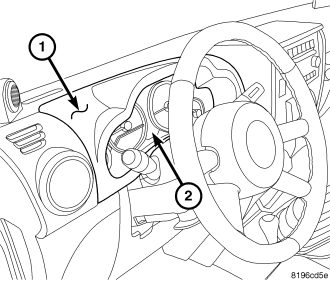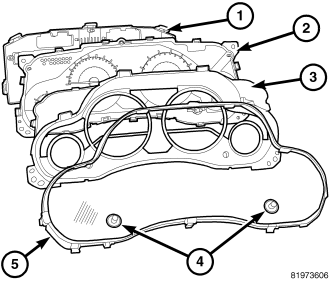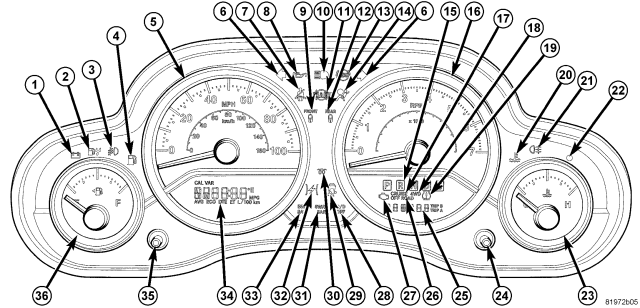

The instrument cluster (2) for this vehicle is an ElectroMechanical Instrument Cluster (EMIC) that is located in the instrument panel above the steering column opening, directly in front of the driver. The remainder of the EMIC, including the mounts and the electrical connections, are concealed within the instrument panel below the cluster bezel (1). The instrument cluster for this vehicle also includes the hardware and software necessary to serve as the electronic body control module and is sometimes referred to as the Cab Compartment Node or CCN.
Besides analog gauges and indicators, the EMIC module incorporates one standard and one optional blue-green digital Vacuum Fluorescent Display (VFD) unit. The standard VFD is a fixed segment unit for displaying odometer information, automatic transmission gear selector position (PRNDL), and several other indicators. The optional Compass Mini-Trip Computer (CMTC) VFD unit is a large fixed segment display unit which serves as the visual display for the compass, the outside temperature, the trip computer, and the audio system settings as well as the user interface for the customer programmable features, numerous textual warning or reminder indicators and certain diagnostic information depending upon vehicle equipment.

The EMIC gauges and indicators are visible through a dedicated opening in the instrument panel below the cluster bezel and are protected by a clear plastic cluster lens (5). Nine integral latch formations on the lens secure it to the cluster hood and mask unit (3) as well as the cluster housing (2). Just behind the cluster lens is the cluster hood and integral mask, which is constructed of molded black plastic. The mask is painted silver on vehicles with certain optional trim packages. The hood serves as a visor and shields the face of the cluster from ambient light and reflections to reduce glare, while the cluster mask serves to separate and define the individual gauges from the indicator areas and trims the outside perimeter of the cluster overlay. The hood and mask has eight integral latch features that secure it to the outer perimeter of the cluster housing. The hood and mask unit also has two integral mounting tabs on the lower corners that combine with the tabs integral to the cluster housing to secure the bottom of the EMIC to the molded plastic instrument panel cluster carrier with two screws.
The rear of the cluster housing and the EMIC electronic circuitry are protected by a molded white plastic rear cover (1), which is also secured to the cluster housing by integral latch features. The rear cover includes clearance holes for the four cluster connector receptacles. The connector receptacles on the back of the cluster electronic circuit board connect the EMIC to the vehicle electrical system through four take outs with connectors from the instrument panel wire harness.
Sandwiched between the rear cover and the lens and hood unit is the cluster housing. The molded white plastic cluster housing serves as the carrier for the cluster circuit board and circuitry, the cluster connector receptacles, the two major and two minor gauges, a Light Emitting Diode (LED) for each cluster indicator, the VFD display units, an audible tone transducer, several LED units for general cluster illumination, the cluster overlay, and the gauge pointers. The standard equipment molded black plastic odometer/trip odometer switch button as well as the optional CMTC display switch button extend from the face of the cluster housing through dedicated holes in the cluster mask and the cluster lens adjacent to their respective VFD units. A black rubber boot (4) seals each switch button to the clearance hole in the lens. The cluster housing also has four integral mounting tabs, one on each upper and lower corner of the housing.
The cluster overlay is a laminated plastic unit. The dark, visible, outer surface of the overlay is marked with all of the gauge dial faces and graduations, but this layer is also translucent. The darkness of this outer layer prevents the cluster from appearing cluttered or busy by concealing the cluster indicators that are not illuminated, while the translucence of this layer allows those indicators and icons that are illuminated to be readily visible. The underlying layer of the overlay is opaque and allows light from the LED for each of the various indicators and illumination lamps behind it to be visible through the outer layer of the overlay through predetermined stencil-like cutouts. Openings in the overlay at the base of the speedometer and tachometer dial faces have smoked clear lenses through which the illuminated VFD units can be viewed.
Several versions of the EMIC module are offered on this vehicle. These versions accommodate all of the variations of optional equipment and regulatory requirements for the various markets in which the vehicle is offered. The microprocessor-based EMIC utilizes integrated circuitry and information carried on the Controller Area Network (CAN) data bus and the Local Interface Network (LIN) data bus along with several hard wired analog and multiplexed inputs to monitor sensors and switches throughout the vehicle. In response to those inputs, the internal circuitry and programming of the EMIC allow it to control and integrate many electronic functions and features of the vehicle through both hard wired outputs and the transmission of electronic message outputs to other electronic modules in the vehicle over the CAN and LIN data busses. (Refer to 8 - ELECTRICAL/ELECTRONIC CONTROL MODULES/COMMUNICATION - DESCRIPTION - CAN BUS).
Besides typical instrument cluster gauge and indicator support, the electronic functions and features that the EMIC supports or controls include the following:

The EMIC houses 4 analog gauges and has provisions for up to 25 indicators. Some of the EMIC indicators are automatically configured when the EMIC is connected to the vehicle electrical system for compatibility with certain optional equipment or equipment required for regulatory purposes in certain markets. While each EMIC may have provisions for indicators to support every available option, the configurable indicators will not be functional in a vehicle that does not have the equipment that an indicator supports.
The EMIC includes the following analog gauges:
The EMIC includes the following VFD units:
The EMIC includes provisions for the following indicators:
Each indicator in the EMIC, except those located within a VFD unit, is illuminated by a dedicated LED that is soldered onto the EMIC electronic circuit board. Cluster illumination is accomplished by several dimmable LED units, which illuminate each of the gauge dial faces for visibility when the exterior lighting is turned ON. These LED units are not available for service replacement and, if damaged or ineffective, the entire EMIC must be replaced.
Hard wired circuitry connects the EMIC to the electrical system of the vehicle. These hard wired circuits are integral to several wire harnesses, which are routed throughout the vehicle and retained by many different methods. These circuits may be connected to each other, to the vehicle electrical system and to the EMIC through the use of a combination of soldered splices, splice block connectors, and many different types of wire harness terminal connectors and insulators. Refer to the appropriate wiring information. The wiring information includes wiring diagrams, proper wire and connector repair procedures, further details on wire harness routing and retention, as well as pin-out and location views for the various wire harness connectors, splices and grounds.
The EMIC module for this vehicle is serviced only as a complete unit. The EMIC module cannot be adjusted or repaired. If a gauge, an LED unit, a VFD unit, the electronic circuit board, the circuit board hardware, the cluster overlay or the cluster housing are damaged or ineffective, the entire EMIC module must be replaced. The cluster lens and the cluster hood and mask unit are available for separate service replacement.